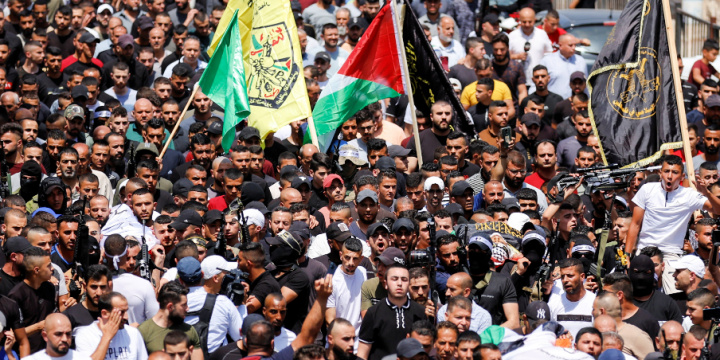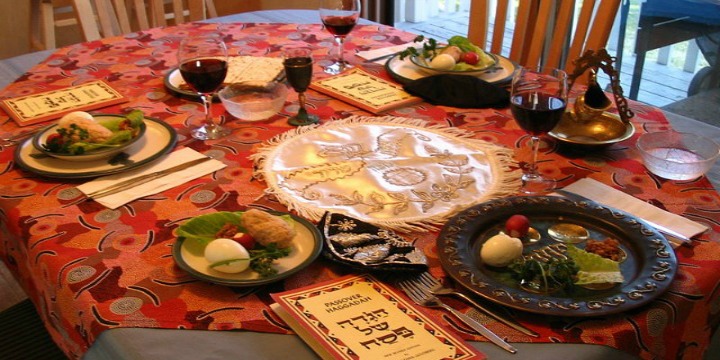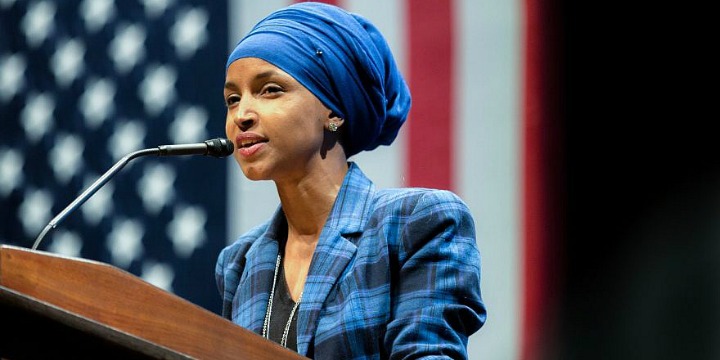‘This is Not Normal’: Antisemitism in Palestinian School Curriculum Persists as Problem Despite Global Outrage, Experts Say
 by Dion J. Pierre
by Dion J. Pierre


Palestinians in Jenin at the funeral of gunman Youssef Salah who was killed in an exchange of fire with Israeli forces. Photo: Reuters/Mohamad Torokman
Study cards for eleventh graders accusing Jews of being “in control of global events through financial power,” seventh graders instructed to describe Israeli soldiers as “Satan’s aides” in a textbook chapter imploring Muslims to “liberate” the Al-Aqsa Mosque, and children gathered to listen to a poem with the following line: “Give me a Kalashnikov, an [M-] 14, an axe and a knife.”
These are some of the examples of the virulent antisemitism experts say continues to show up in educational materials provided to children living in territory controlled by the Palestinian Authority. The problem has persisted despite years of outrage and international pressure and contributes to prolonging the Israeli-Palestinian conflict, experts and lawmakers told The Algemeiner.
“For the Palestinian Authority, the strategy is to use the unique authoritative nature of textbooks to create a society, which is essentially violent,” Marcus Sheff, the CEO of Impact-se, an Israeli education watchdog, told The Algemeiner. “If you look across the Palestinian textbooks from cover to cover, as we have from line to line, there is no Israel. There is a yearning for places located inside of Israel, and there is, if you like, an enthusiasm for violence conveyed in their lauding those who have been violent in the past and in their justifying violence today.”
Educational materials produced by the Palestinian Authority, similar to that issued by Hamas in Gaza, are some of the most antisemitic in the Middle East and North African (MENA) region and reflects Palestinian societies’ larger hopes for a world without a Jewish State, Sheff added.
“What is the strategy of the PA? It is a picture of one state, essentially one Palestine ‘from the river to the sea’ which will be gained by the students through violence,” Sheff continued. “That is the strategy essentially, and you know, this is well understood by many. This is not normal. It should never be considered normal.”
Real World Impact
Exposing Palestinian youth to violent imagery and themes has inspired real-world bloodshed. In May 2022, it was revealed that a 17-year-old who was shot dead after attempting invade an Israeli family’s home in the West Bank while armed with a knife attended a school that taught students to murder Israelis. The twelfth grader attended A-Zeer Boys High School in the Bethlehem Governorate, which used textbooks promoting “Jihad and martyrdom” and described Jews as “dangerous” and “perverted in nature.”
IMPACT-se said at the time that antisemitism at A-Zeer Boys High School is the cornerstone of its educational mission. In February 2020, for example, teachers held an assembly for a reading of poem that said, “The blood of the martyrs calls us … we did not write with ink or pencils or crayons, but with guns.”
This truth holds across the Palestinian territories, where Jew hatred is interdisciplinary. In a science textbook for seventh graders — images of which can be found in a report Impact-se released in May 2021 — Newton’s Second Law of Motion is explained with an illustration depicting a masked Palestinian “aiming a slingshot at approaching soldiers.” In another textbook, titled Mathematics and used in grade nine, a word problem asks students to calculate, based on a given probability, how many Palestinians would be shot by “one of the settlers.”
Global Inaction…Little Change
Antisemitism in Palestinian curricula is well documented, widely studied, and reported on. Yet little has changed in recent years.
In April 2018, the United States Government Accountability Office (GAO) published a report that found textbooks in PA schools featuring erroneous maps of the region, as well as hate-inciting militaristic imagery and content against Jews and Israel. A 2021 EU funded report determined that PA textbooks contained antisemitic tropes, hagiographies of terrorists, and violence against civilians.
In September, The House Foreign Affairs Committee approved legislation — the “Peace and Tolerance in Palestinian Education Act” — coauthored by U.S. Congressmen Brian Mast (FL-18) and Brad Sherman (CA-30) aimed at preventing US tax dollars from funding antisemitic education materials in schools in the Gaza Strip. In a press release, Sherman stressed that US support for Palestinians “is not a blank check” and argued that curricula in schools administered by the Palestinian Authority and UNWRA are antithetical to US values of “tolerance and peacebuilding.”
“Ending incitement and violence in the curriculum taught to Palestinian schoolchildren isn’t only a matter of Israel’s security – it’s an obligation that the Palestinian Authority and UNRWA owes their beneficiaries, children who deserve quality education,” he continued.
The bill, however, has floundered and is yet to be considered by the House of Representatives.
A Larger Problem
The litany of reports, resolutions, and political reprimands from lawmakers have never persuaded the Palestinian Authority to reform its educational system, Sheff said, which is characteristic of a broader pattern of intransigence that he argued only a holistic reformation of Palestinian culture and politics can change.
Similar content, experts said, is also featured in materials produced for students in Gaza by the United Nations Relief and Works Agency (UNRWA), which received over $511.5 million in funding from the European Union and United States in 2021. In May, the EU announced that it would contribute $266 million to the agency through 2024.
Examples included in Impact-se’s findings include a grammar lesson that uses the sentence, “The Palestinians sacrifice their blood to liberate Jerusalem,” and “Arabic Drill Cards” for 9th graders that say, “When the [Muslim] nation is negligent in protecting al-Aqsa, then the Jews will dare to defile it.” Neither does Israel appear on any maps. Much of the material is “UNRWA branded,” but it cannot be accessed through its online education portal and is essentially hidden from public scrutiny.
Continued oversight could prompt meaningful reforms, David May, researcher at the Washington DC based think tank Foundation for the Defense Democracies, told The Algemeiner.
“Outside organizations taking a look at Palestinian curriculum and educational materials, seeing what is problematic, would help. And the next step, which is key, is implementing necessary changes,” May said. “The more that we can persuade donor countries to make their support contingent on certain reforms, the more we can ensure that it becomes clear that educational materials simply do not have any room for antisemitism, promotion of martyrdom, and promotion of violence against Israelis.”
May added that when it comes to UNRWA, the United Nations has an obligation not to “be in the business of promoting antisemitism.”
A New Model? Slow Progress Elsewhere in Arab World
Other MENA countries, such as Qatar, have “slowly” made progress towards eliminating antisemitism from its curricula. The oil rich Gulf state has removed antisemitic content describing Jews as treacherous, immoral, and responsible for Germany’s loss in World War I.
Additionally, an entire 11th grade social studies textbook that said the Nazi Party ascended to power in Weimar Germany because Jews were “manipulating financial markets” was removed. Another textbook was stripped of the false conspiracy theory that “the Jews” were responsible for a 1969 arson attack on the Al-Aqsa Mosque in Jerusalem. Some nationalist, anti-Israel themes remain, however, and the efforts of Israeli and Arab nations to normalize relations are opposed.
Points of concern remain unaddressed, including negative portrayals of non-Muslims and polytheists, and the omission of the Holocaust from a 12th grade history book chapter on World War II. In a 6th grade Islamic Education lesson, students are taught that women’s ultimate life goals are child bearing and jihad.
In 2020, Morocco became the first Arab country to include Jewish history in its school curriculum, and today, according to analysis by the Anti-Defamation League (ADL), it promotes appreciation of Jews and educates students about their contributions to the country. One example cited by the ADL shared a story titled “Hosted by Sami” about a friendship between three Jewish and Muslim Moroccan youth, Sami, Ibrahim, and Idris. It ends with Sami’s mother serving them “a mouthwatering dish” called Skinha on the Sabbath.
Others emphasized the Kingdom’s constitutional commitment to anti-discrimination, highlighting its antecedent in the long history of coexistence and cultural exchange between its Christians, Muslims, Jews, and various ethnic groups.
 Police Stop Anti-Zionist Agitators From Accessing Florida University President’s Home as Students Revolt Nationwide
Police Stop Anti-Zionist Agitators From Accessing Florida University President’s Home as Students Revolt Nationwide Nearly One in Five Young People Sympathize With Hamas, 29% Say US Should Reduce or End Alliance With Israel: Poll
Nearly One in Five Young People Sympathize With Hamas, 29% Say US Should Reduce or End Alliance With Israel: Poll Ilhan Omar Silent After Daughter’s Arrest, Suspension for Role in Columbia University Anti-Israel Protest
Ilhan Omar Silent After Daughter’s Arrest, Suspension for Role in Columbia University Anti-Israel Protest Cultural Center Backed by Iran’s Revolutionary Guard Plans to Produce Films About Attack on Israel
Cultural Center Backed by Iran’s Revolutionary Guard Plans to Produce Films About Attack on Israel How Does Ilhan Omar Really Feel About Iran?
How Does Ilhan Omar Really Feel About Iran? This Passover, Combine Respect for Tradition with the Courage to Innovate
This Passover, Combine Respect for Tradition with the Courage to Innovate Israel’s Iran Attack Carefully Calibrated After Internal Splits, US Pressure
Israel’s Iran Attack Carefully Calibrated After Internal Splits, US Pressure Palestinian Cameramen Exposed in New Footage Documenting Oct. 7 Atrocities Side by Side with Terrorists
Palestinian Cameramen Exposed in New Footage Documenting Oct. 7 Atrocities Side by Side with Terrorists US Money to Convicted Terrorists; US Training to Aspiring Terrorists
US Money to Convicted Terrorists; US Training to Aspiring Terrorists Man Arrested in Paris After Iran Consulate Incident
Man Arrested in Paris After Iran Consulate Incident



 Israel’s Iran Attack Carefully Calibrated After Internal Splits, US Pressure
Israel’s Iran Attack Carefully Calibrated After Internal Splits, US Pressure This Passover, Combine Respect for Tradition with the Courage to Innovate
This Passover, Combine Respect for Tradition with the Courage to Innovate How Does Ilhan Omar Really Feel About Iran?
How Does Ilhan Omar Really Feel About Iran? Cultural Center Backed by Iran’s Revolutionary Guard Plans to Produce Films About Attack on Israel
Cultural Center Backed by Iran’s Revolutionary Guard Plans to Produce Films About Attack on Israel Ilhan Omar Silent After Daughter’s Arrest, Suspension for Role in Columbia University Anti-Israel Protest
Ilhan Omar Silent After Daughter’s Arrest, Suspension for Role in Columbia University Anti-Israel Protest